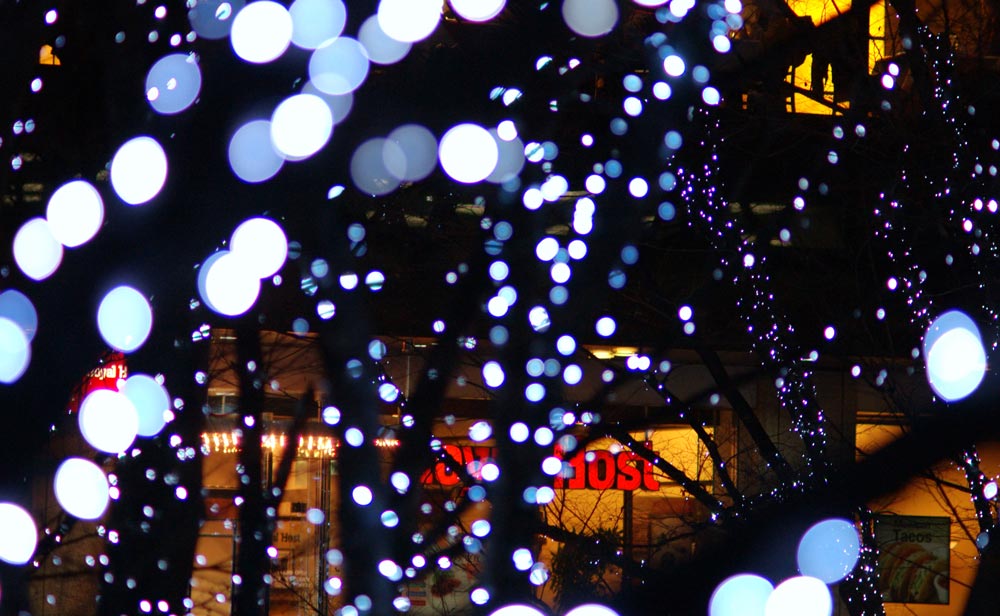NIKKOR - The Thousand and One Nights No.30

Ai Nikkor 135mm F2
Bokeh, defocused imaging, is one of the photography-specific techniques, which isolates the main subject by throwing the foreground and background out of focus. It was developed with the emergence of compact-sized, hand-held cameras such as Leica and Rolleiflex.
by Kouichi Ohshita
Hand-held shooting requires higher shutter speeds and often involves use of full-open aperture, which can cause out-of-focus areas in the foreground and/or background of the main subject. To enable expanding the applications to night or indoor photography, the lenses for the compact-size cameras ultimately evolved into ultralarge diameter lens such as the Nikkor 50mm f/1.1 discussed in Tale Seven. This trend towards larger diameter lens led to the incidental effect of blurring away everything other than the main subject and omitting the foreground and background, which might have helped establish the photographic technique of utilizing bokeh.
Concurrently, an issue relating to defocusing characteristics came up. It addressed the difference between out-of-focus images and/or the quality of defocusing, since out-of-focus areas occupy a large part of photographs taken with a large diameter lens at full-open aperture, and only the main subject is in sharp focus. Tonight, let's look at the Ai AF DC Nikkor 135mm f/2S, which was developed to pursue high-quality defocusing, and over two nights we will look at the history of the development of high-speed medium telephoto lens up to this lens.
I. NEW Nikkor Auto 135mm f/2
Nikkor Auto 85mm f/1.8 was put on sale in 1964 as the high-speed medium telephoto lens for Nikon F. It was a Gauss-type lens developed by completely redesigning the lens configuration of the well-established and popular 8.5cm f/2-S lens (Sonnar-type), which was already available at that time even though it did not have sufficient back focus for single-lens reflex (SLR) cameras.
In the following year, 1965, Nikkor Auto 135mm f/2.8 was released, and in 1971, the newly designed Nikkor Auto 105mm f/2.5 discussed in Tale Five and the Nikkor Auto 180mm f/2.8 were put on sale, although the f/2 or faster telephoto lenses were not available for a while. Then, five years after the introduction of 180mm f/2.8 and twelve years after the introduction of 85mm f/1.8, the second high-speed medium telephoto lens NEW Nikkor Auto 135mm f/2 was released in 1976.
While the 135mm f/2 and 85mm f/1.8 lenses are classified into the same category as high-speed medium telephoto lens, they seem to differ considerably in terms of the characteristic of lens. The 85mm f/1.8 was just a substitute lens for the 85mm f/2-S, featuring a greater focal length than the fast standard lens. In contrast to this, the 135mm f/2 appears to have been developed as a shorter focal length version of 180mm f/2.8, 300mm f/2.8 or other high-speed telephoto lenses. In short, I suppose that the 85mm was developed primarily to provide a faster lens whereas the 135mm was designed by placing the emphasis on the characteristics of bokeh, and not just on the brightness of the lens.
The extent of the out-of-focus background caused by a lens depends on the distance between the subject and the background, the aberration of the lens and other factors, and thus it may be roughly proportional to the effective diameter of lens although this is not generally defined. Sorry for having to bother you with a formula, but we can determine the effective diameter of lens by the following equation based on the definition of F-number:
(Effective diameter) = (Focal length)/(F-number)
Reference manuals for lenses or photography in general often instruct the readers to use a lens with a longer focal length, to use a faster lens, to move closer to the subject, and/or to locate the background away from the subject in order to defocus the background.
Well, have you ever wondered which is more likely to result in out-of-focus images, a slow telephoto lens or a fast standard lens? In this case, determine the effective diameter of lens, and you should be able to find the solution.
The proportional relationship between the effective diameter of lens and the extent of defocusing is also effective for making comparisons between cameras with different format sizes. I've been asked at times how defocusing characteristics vary between a film camera such as F6 and a digital camera such as D2 when the same lens is mounted, while the angles of view become changed between the two cameras. In this case, the effective diameter remains unchanged, thus, the extent of the out-of-focus background would be roughly similar if the subject were shot in the same ratio to the screen and printed ultimately in the same size.
II. Lens configuration

I've gotten off the subject. Let's revert to the tale about 135mm f/2.
The 135mm f/2 lens is configured with a 4-group, 6-element lens known as the variant Ernostar type, as shown in Fig. 1. The Ernostar type refers to a 4-group, 4-element lens configuration, in which the 3-element cemented lens in the 3-group, 5-element telescopic Sonner-type lens such as the 85mm f/2-S and the 105mm f/2.5-S are replaced by the two lenses, convex and concave, and is thus suited for designing fast telephoto lenses in a simple configuration. Based on the Ernostar-type lens configuration, the second and third lens are cemented to each other to provide a unique lens configuration, and this lens system offers superior compensation for chromatic aberration, spherical aberration, and other aberrations. The Ernostar type provides an asymmetrical lens configuration close to the telephotographic type and thus offers the advantage of a shorter overall lens length. The lens is compact enough for the f/2 large-diameter lens. The lens was designed by Sei Matsui, who was also responsible for designing the 180mm f/2.8.
III. Imaging characteristics
This lens is packed with the results of the 12 years of lens research and development that followed the introduction of the 85mm f/1.8. This is amply demonstrated, for example, by the beauty of the out-of-focus background. Generally, all-element-focusing with a large diameter lens involves insufficient compensation for spherical aberration in the shorter focusing ranges, causing the coma that is characterized by flare spreading outward from the center of the image. The Ernostar type, which features a highly asymmetrical lens configuration, is likely to cause more significant fluctuating aberrations compared to the Gauss-type, which features a symmetrical lens configuration.
However, this lens makes good use of the characteristics; it provides sharp images in the long-range shots and leaves spherical aberration and coma in the short-range photos, thereby representing the smoothly melted edges of out-of-focus images. This is achieved based on a variety of analytical results on the lenses designed and released during that period. Because it provides a beautiful out-of-focus background and a rich color reproduction, achieved thanks to the lens coating and the adequately controlled internal reflection, this lens is one of the recommended choices for portraits.

Nikon D50
Ai Nikkor 135mm f/2 f/2 1/800 sec. ISO200
(NEF file developed by Nikon Capture)
(C)2006/2007 Kouichi Ohshita

Nikon D50
Ai Nikkor 135mm f/2 f/8 1/500 sec. ISO200
(NEF file developed by Nikon Capture)
(C)2006/2007 Kouichi Ohshita

Nikon D50
Ai Nikkor 135mm f/2 f/2 1/125 sec. ISO800
(NEF file developed by Nikon Capture)
(C)2006/2007 Kouichi Ohshita
Now, let's check what this lens can do based on sample photographs. The sample photos shown here were shot with the digital camera D50, and the angle of view is equivalent to that of a telephoto lens with a focal length of 200mm. This lens provides uniform imaging characteristics and the basic characteristics of representation remain unchanged even when a digital cameras is used, although flare and chromatic aberration are more visible due to spherical aberration and coma since the central part of the screen is enlarged.
Sample 1 shows a sasanqua flower shot at a full-open aperture. It may be difficult to clearly see it on the printed media, but you should be able to find that the edges are defocused as they merge from the sharply focused stamens in the front into the background, while the outline of the subject is left crisply identifiable.
Sample 2 is a long-range shot with the lens stopped down to f/8. The image is entirely uniform, and so sharp that the characters on the signboard and the people walking on the pavement can be clearly identified. At the image periphery, a slightly colored border is seen due to the transverse chromatic aberration. It may be made almost invisible by photographing in the NEF file format (RAW) and treating the "chromatic aberration correction" during the development process by Nikon Capture. (This sample is intended for the evaluation of lens imaging characteristics, and chromatic aberration correction was not done.)
Sample 3 shows a night view taken at full-open aperture. I brought the farthest position into focus and placed the defocused illumination in the foreground to create an atmosphere of fantasy. Compared to the out-of-focus background in Sample 1, the edge of the out-of-focus foreground is clear, crisp and sharp. However, the out-of-focus areas do not break down to any ring or off-axis aberration, maintaining an excellent balance.
As seen from the above sample, when you suppress the compensation for spherical aberration to defocus the edge of out-of-focus background, you can obtain an out-of-focus foreground with sharp edges. On the other hand, if you try to make the out-of-focus foreground look beautiful, the out-of-focus background becomes hard. Optically, it is impossible to simultaneously blur both the front and back and make them look beautiful. This is what drove the development of DC NIKKOR.
IV. Expansion of the lineup of high-speed medium telephoto lenses
The NEW Nikkor Auto 135mm f/2 came out with the Ai system in 1977, the year after the market introduction in 1976, and went on sale concurrently with the Ai Nikkor 85mm f/2. Then Ai Nikkor 105mm f/1.8S (in 1981) and Ai Nikkor 85mm f/1.4S (in 1981) were put on sale in rapid succession, and the full lineup of high-speed medium telephoto lenses in the manual focusing age was attained. The first half of 1980s was the golden age of medium telephoto lenses. However, from 1986 onwards, the environment surrounding the medium telephoto lenses started changing quickly. Adoption of the Automatic Focusing (AF) system was encouraged, starting with F-501.
Lenses had to be motor-driven in order to offer the AF function. In practice, however, normal lenses could be designed as motor-driven without any specific interference, although it was difficult to move the heavyweight 135mm f/2 lens at a high speed. As you can imagine, there was an option to design an all-element-focusing lens by forgoing the speed of AF. However, did it convince end users that large-diameter lenses or high-grade lenses provided slower AF speeds compared to popular lenses?
At that time, high-speed medium telephoto lenses were on the verge of extinction. What became of high-speed medium telephoto lenses after this? I'll talk about the move toward AF DC 135mm f/2 on the next night.

NIKKOR - The Thousand and One Nights
The history of Nikon cameras is also that of NIKKOR lenses. This serial story features fascinating tales of lens design and manufacture.

